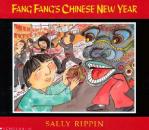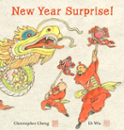AustLit
The material on this page is available to AustLit subscribers. If you are a subscriber or are from a subscribing organisation, please log in to gain full access. To explore options for subscribing to this unique teaching, research, and publishing resource for Australian culture and storytelling, please contact us or find out more.
Latest Issues
AbstractHistoryArchive Description
Fang Fang's fears that her friend Lisa won't enjoy the Chinese New Year celebrations are put to rest as Lisa has a wonderful time tasting the different foods and watching the Dragon Dance.
Affiliation Notes
-
This work is affiliated with the AustLit subset Asian-Australian Children's Literature and Publishing because it has Chinese cultural references.
Publication Details of Only Known VersionEarliest 2 Known Versions of
Works about this Work
-
Exclusions and Inclusions : Multiculturalism in Contemporary Taiwanese and Australian Picturebooks
2007
single work
criticism
— Appears in: Bookbird , vol. 45 no. 3 2007; (p. 5-12) Australia and Taiwan have in common a history of colonisation and ethnic diversity and troubled ideas about national and cultural identity. Bradford suggests that many of the picture books discussed in this article express allegorical rather than realistic treatments of cross-cultural relations. -
The New Fringe Dwellers : The Problem of Ethnicity in Recent Australian Children's Picture Books
1997
single work
criticism
— Appears in: Old Neighbours, New Visions 1997; Papers : Explorations into Children's Literature , August vol. 9 no. 2 1999; (p. 31-39) Kroll looks at several children's texts in an effort to investigate a number of questions pertinent to the issue of moving the representation of ethnic groups 'beyond the immigration experience in literature so that the ethnicity of non-Anglo characters is no longer the focus' (31). This includes clarifying the cultural norms against which such characters are pitted, investigating the significance of the landscape in defining nationality and finally, considering whether having more authors/illustrators of non-Anglo origin in the field would 'alter the representation of ethnic groups' (31). She concludes that 'the appearance of non-Anglo children or adults as picture book protagonists has not increased to a substantial degree in recent years' and while ethnic characters are 'visible', the lack of centrality given to migrant groups and individuals continues the process of marginalization, tokenism and stereotyping which continues to dominate representations of non-Anglo experiences in Australian picture books (38). -
[Review] Speak Chinese, Fang Fang! [and] Fang Fang's Chinese New Year
1996
single work
review
— Appears in: Reading Time : The Journal of the Children's Book Council of Australia , November vol. 40 no. 4 1996; (p. 23)
— Review of Speak Chinese, Fang Fang! 1996 single work picture book ; Fang Fang's Chinese New Year 1996 single work picture book -
[Review] Speak Chinese, Fang Fang! [and] Fang Fang's Chinese New Year
1996
single work
review
— Appears in: Magpies : Talking About Books for Children , September vol. 11 no. 4 1996; (p. 29-30)
— Review of Speak Chinese, Fang Fang! 1996 single work picture book ; Fang Fang's Chinese New Year 1996 single work picture book
-
[Review] Speak Chinese, Fang Fang! [and] Fang Fang's Chinese New Year
1996
single work
review
— Appears in: Reading Time : The Journal of the Children's Book Council of Australia , November vol. 40 no. 4 1996; (p. 23)
— Review of Speak Chinese, Fang Fang! 1996 single work picture book ; Fang Fang's Chinese New Year 1996 single work picture book -
[Review] Speak Chinese, Fang Fang! [and] Fang Fang's Chinese New Year
1996
single work
review
— Appears in: Magpies : Talking About Books for Children , September vol. 11 no. 4 1996; (p. 29-30)
— Review of Speak Chinese, Fang Fang! 1996 single work picture book ; Fang Fang's Chinese New Year 1996 single work picture book -
Exclusions and Inclusions : Multiculturalism in Contemporary Taiwanese and Australian Picturebooks
2007
single work
criticism
— Appears in: Bookbird , vol. 45 no. 3 2007; (p. 5-12) Australia and Taiwan have in common a history of colonisation and ethnic diversity and troubled ideas about national and cultural identity. Bradford suggests that many of the picture books discussed in this article express allegorical rather than realistic treatments of cross-cultural relations. -
The New Fringe Dwellers : The Problem of Ethnicity in Recent Australian Children's Picture Books
1997
single work
criticism
— Appears in: Old Neighbours, New Visions 1997; Papers : Explorations into Children's Literature , August vol. 9 no. 2 1999; (p. 31-39) Kroll looks at several children's texts in an effort to investigate a number of questions pertinent to the issue of moving the representation of ethnic groups 'beyond the immigration experience in literature so that the ethnicity of non-Anglo characters is no longer the focus' (31). This includes clarifying the cultural norms against which such characters are pitted, investigating the significance of the landscape in defining nationality and finally, considering whether having more authors/illustrators of non-Anglo origin in the field would 'alter the representation of ethnic groups' (31). She concludes that 'the appearance of non-Anglo children or adults as picture book protagonists has not increased to a substantial degree in recent years' and while ethnic characters are 'visible', the lack of centrality given to migrant groups and individuals continues the process of marginalization, tokenism and stereotyping which continues to dominate representations of non-Anglo experiences in Australian picture books (38).
Awards
Last amended 11 Aug 2014 11:12:05
Settings:
-
cAustralia,c
Export this record





